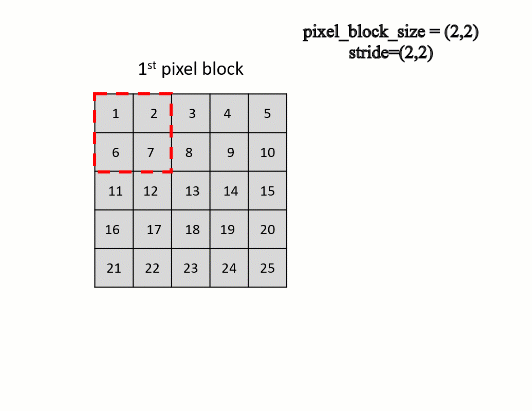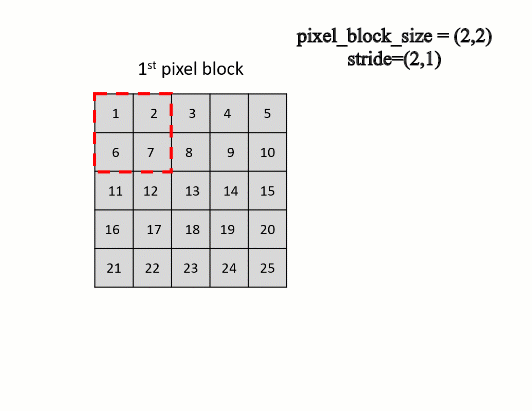Zusammenfassung
Establishes read-only access to all pixel blocks from a raster or list of rasters.
Diskussion
The PixelBlockCollection object is an iterator of all PixelBlock objects in a raster or a list of rasters. It can be used to perform customized raster processing on a block-by-block basis, when otherwise the processed rasters would be too large to load into memory.
The PixelBlockCollection class supports a single raster or a list of rasters as input. Given a single-raster input, the output will have two dimensions, (number of pixel blocks along y, number of pixel blocks along x). For example, to access the first pixel block in the input raster, use the following:
pixelblockcoll = PixelBlockCollection(in_raster)
numpy_array = pixelblockcoll[0][0].getData()Given a list of rasters as input, the output will have three dimensions, (number of pixel blocks along y, number of pixel blocks along x, number of input rasters). For example, to access the first pixel block from the second raster in the list, use the following:
pixelblockcoll = PixelBlockCollection(in_raster1, in_raster2)
numpy_array = pixelblockcoll[0][0][1].getData()The PixelBlockCollection class's stride argument designates the number of bytes from one row of pixels in memory to the next row of pixels in memory. This is also known as increment, pitch, or step size. The following graphic shows how the PixelBlockCollection object iterates through pixels when the stride is set to the default, which is the same size as the pixel block size:

The following graphic shows how the PixelBlockCollection object iterates through pixels when the stride is set to (2, 1):

Syntax
PixelBlockCollection (in_rasters, pixel_block_size, stride, overlay_type, nodata_to_values)
| Parameter | Erläuterung | Datentyp |
in_rasters [in_rasters,...] | The input raster object or a list of raster objects. If you're using a list of raster objects, the rasters must all have the same cell size and spatial reference. | Raster |
pixel_block_size | A tuple with two values describing the block size (number of rows, number of columns). (Der Standardwert ist (512, 512)) | tuple |
stride | A tuple with two integers specifying the stride or increment along the rows and columns for processing. If no value is specified, the pixel block size will be used, and adjacent pixel blocks will have no overlap. (Der Standardwert ist None) | tuple |
overlay_type | Specifies the overlay type when input rasters have different extents.
(Der Standardwert ist INTERSECTION) | String |
nodata_to_values [nodata_to_values,...] | The value to assign to NoData values from the input rasters in the resulting NumPy array. This can be a single value or a list of values, one for each raster. | Integer |
Eigenschaften
| Eigenschaft | Erläuterung | Datentyp |
| size (Schreibgeschützt) | The number of pixel blocks along the y- and x-directions in the pixel block collection. The number of pixel blocks in the y-direction is in the first position. | tuple |
Methodenübersicht
| Methode | Erläuterung |
| reset () | Resets the pixel block collection iterator to the beginning of the collection. |
| shuffle () | Shuffles the pixel blocks in the pixel block collection. This is useful when feeding image samples into a deep learning model. |
Methoden
reset ()
| Datentyp | Erläuterung |
| PixelBlockCollection | The PixelBlockCollection object that has been reset. |
shuffle ()
| Datentyp | Erläuterung |
| PixelBlockCollection | The PixelBlockCollection object with pixel blocks in shuffled order. |
Codebeispiel
Iterates through pixel blocks to calculate the total urban area in a land cover raster.
import arcpy
# Specify the input raster
in_raster1 = arcpy.Raster("landcover.tif")
# Create a PixelBlockCollection
blockCollection = arcpy.ia.PixelBlockCollection(
in_raster1, pixel_block_size = (512, 512), nodata_to_values = -1)
# Check the number of pixelblocks along x and y direction
number_blocks_y, number_blocks_x= blockCollection.size
urban_cell_count=0
# Iterate through each PixelBlock
for i in range(number_blocks_y):
for j in range(number_blocks_x):
pixelblock = blockCollection[i,j]
np_array = pixelblock.getData()
urban_cell_count+= np.count_nonzero(np_array == 3)
# value = 3 is urban class
urban_area = urban_cell_count * in_raster1.meanCellWidth*in_raster1.meanCellHeight
print("Total urban area : " + str(urban_area))Iterates through pixel blocks to calculate the total area that changed from forest in 2006 to urban in 2016.
import arcpy
from arcpy.ia import *
# Specify the input rasters
in_raster1 = arcpy.Raster("C:/iapyexamples/data/landcover_2006.tif")
in_raster2 = arcpy.Raster("C:/iapyexamples/data/landcover_2016.tif")
# Create a PixelBlockCollection
blockCollection = arcpy.ia.PixelBlockCollection(
[in_raster1, in_raster2], pixel_block_size = (256, 256), nodata_to_values = -1)
# Check the number of pixelblocks along x and y direction
number_blocks_y, number_blocks_x= pixelblocks.size
forest_to_urban_cell_count = 0
# Iterate through each PixelBlock
for i in range(number_blocks_y):
for j in range(number_blocks_x):
pixelblocklist = blockCollection[i][j]
# get the array from pixelblock in the 1st raster
array_in_raster1 = pixelblocklist[0].getData()
# get the array from pixelblock in the 2nd raster
array_ in_raster2 = pixelblocklist[1].getData()
forest_in_raster1= array_in_raster1[array_in_raster1==1] # value = 1 is forest class
urban_in_raster2= array_in_raster2[array_in_raster2==3] # value = 3 is urban class
res= forest_in_raster1+ urban_in_raster2
forest_to_urban_cell_count+= np.count_nonzero(res == 4) # value = 4 is forest in in_raster1 and urban in in_raster2
forest_to_urban_area= forest_to_urban_cell_count * in_raster1.meanCellWidth*in_raster1.meanCellHeight
print("total area from forest in 2006 to urban in 2016 : " + str(forest_to_urban_area))